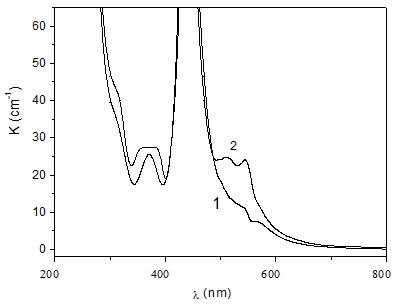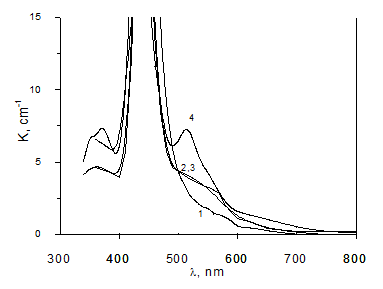ПОСТРАДИАЦИОННОЕ НАКОПЛЕНИЕ F4 ЦЕНТРОВ В ГАММА-ОБЛУЧЕННЫХ КРИСТАЛЛАХ LiF
Надарейшвили М.М.1, Абрамишвили М.Г.2, Квачадзе В.Г.3, Цакадзе С.Дж.4
1Кандидат физ.мат.наук, 2Кандидат физ.мат.наук, 3доктор физ.мат.наук, 4Кандидат физ.мат.наук Тбилисский государственный университет, институт физики им.Э.Андроникашвили
ПОСТРАДИАЦИОННОЕ НАКОПЛЕНИЕ F4 ЦЕНТРОВ В ГАММА-ОБЛУЧЕННЫХ КРИСТАЛЛАХ LiF
Аннотация
Исследовано пострадиационное накопление F4 центров в гамма-облученных(1÷5x106R) кристаллах LiF после комбинированного (одновременного или последовательного) воздействия умеренным теплом (температура отжига 140-160 °С) и постоянным электрическим полем (1800-3000 V). Проведен анализ полученных результатов.
Ключевые слова: гамма облучение, центры окраски, F4 центры.
Nadareishvili M.M.1, Abramishvili M.G.2, Kvachadze V.G.3, Tsakadze S.J.4
1PhD in Physics and Mathematics, 2PhD in Physics and Mathematics, 3Doctor of Phyz. Math.Sciences, 4PhD in Physics and Mathematics, Tbilisi State University, E.Andronikashvili Institute of Physics
POSTRADIATION ACCUMULATION OF F4 CENTERS IN GAMMA-IRRADIATED LiF CRYSTALS
Abstract
The postirradiation accumulation of F4 centers in gamma-irradiated (1÷5∙106R)LiF crystals was studied. After gamma-irradiation, the LiF crystals were exposed (simultaneously or sequentially) to moderate temperature (140-160°C) and a static electric field (1,800-3,000V). The obtained results are discussed.
Keywords: gamma irradiation, color centers, F4 centers
- Introduction
In the second half of the last century, by various investigation techniques, it was found that, in lithium fluoride monocrystals irradiated with high fluencies (>1018 N/cm2) in the reactor, metal particles 103-104 oA formed. These values are proportional to nanoparticle sizes. Hence the investigation of the mechanisms of colloid particles aggregation will help us to produce metal particles in the medium of interest.
Of special note are the results of postirradiation annealing (400-5000C) of the LiF crystals irradiated in the reactor, particularly the color spots observed by using an optical transmission microscope [1]. By microspectrophotometric analyses of such crystals, absorption bands with maxima at wavelengths 462,487,515 and 525nm were recorded. According to K. Kubo, the above-mentioned color spots were due to the absorption of lithium particles of different sizes formed in the crystal.
At that time it was popular to study colloid particles and their precursors, quasicolloid ones, by annealing the samples irradiated in the reactor.However, the annealing failed to serve completely the function of selection for separating and investigating one or other process. First, the annealing was carried out at rather high temperature (>3000C) which could reduce the resources of color centers and hence limit the evolution of complex centers. At the same time, the particles formed were not uniform in size, etc.
Besides, the examination of colloid particles in the LIF monocrystals by the method of optical absorption is hindered by the fact that the optical absorption band of colloid particles (450-550nm [1]) is overlapped by that of complex color centers F4(N1,N2) (N1-517nm, N2-549nm[2]). Moreover, when the mechanism of aggregation of the colloid centers is considered, the F4 centers could be one of the elements in the formation of colloid centers. A comprehensive investigation of these centers has not been feasible so far, which is confirmed by the statement of the authors of work [2]. From the preceding, the necessity in the investigation of the above-mentioned problems by relatively novel methods is evident. We believe that the methods of the combined action of various external fields on colored alkaline halide crystals could be efficient in this field. The investigation results reported in work [3] argue in favor of this idea. In that investigation, colored crystals were exposed to UV radiation and the static electric field. In this manner, stable F2+centers, which usually disintegrate at rooms temperature, were obtained.
Thus, based on the previous experience, it is possible to create such a combination and conditions of external fields that will work in the given spectrum region. For instance, when a combination of UV radiation, for the ionization of neutral centers, and the static electric field is used for production of stable F2+ centers in preliminarily colored LiF crystals, moderate temperature (which will promote the diffusion of existing elemental centers and, at the same time, will not reduce the resources of color centers) and the electric field would be appropriate to use.
- Samples and Methods
The test samples (0.5×1.0×1.0cm in dimensions) were cut out of the LiFmonocrystal block. Among the impurities, bivalent Mg ions prevailed (≈2.6×10-3 wt. %). The amount of other impurity ions (Fe, Pb, Si, Mn, Al and Cu) did not exceed ≈10-4 wt. % in total.
The gamma-irradiation was performed in an indium-gallium gamma loop allowing carry out the irradiation at room temperature, the radiation dose 8×10-5R with the maximum energy of gamma-rays 2.1 MeV.
The optical absorption spectra were detected in the wavelength range from 200 to 900nm at room temperature with the help of spectrophotometer AvaSpec-2048.
- Results and Discussion
Figure1 shows the optical absorption spectra of colored LiF (gamma-irradiation 5×10-6 R) before the treatment (Curve1) and after the combined treatment (Curve2).
Fig.1 - Optical absorption spectra of gamma-irradiation (5×10-6 R) LiF crystals: Curve1- before treatment; Curve2- after combined treatment;
The static electric field was applied to the sample at 150 0C (U= 3KV, exposure 4 hours). The spectrum recorded after switching-off of the electric field and cooling of the sample to room temperature showed a distinct increase in the number of aggregate centers F3 (R1-316 nm, R2-374nm) and F4 (N1-505nm, N2-549nm) (Fig.1, Curve 2). This occurred at the expense of F and F2 centers:
ΔKF =KOF – KIF = 200 – 170 = 30 cm-1; ΔKF2 =KOF2 – KIF2 = 133-98 = 41 cm-1, where ΔKF and ΔKF2, and KOF, KIF, KOF2 and KIF2 are the absorption coefficients at maxima of the F and F2 bands before the combined treatment and after it, respectively.
By selecting the conditions of the combined treatment, it must be possible to produce bigger quasicolloid Formations, i.e. to create such a medium depleted in fluoride that will promote the second-kind phase transition and the formation of the metal phase in the alkaline halide crystal.
For the analysis of the combined action fields, it was of interest to determine the share of each field separately.
Fig2. Optical absorption spectra of gamma-irradiated LiF crystals (1.5×106 R): Curve 1- before annealing; Curve 2 and 3-after annealing at 140 and 1600C, respectively; Curve 4- after combined treatment.
In order to clear up the action of each field, we took the crystals irradiated with a lower dose (<5×106R). In Fig. 2, Curve 1 corresponds to the LiF sample after irradiation (1.5×106R). Curve 2 and 3 to the irradiated sample after annealing at 140 and 1600C, respectively, for 3 hours. Curves 2 and 3 coincided in spite of temperature difference of 200C. When, alongside with annealing, the electric field (U=1800 V) was applied to the sample, Curve 4 was recorded. The intensity of the main maximum (λ=510nm) doubled. Besides, the Formation of F2+centers was observed as indicated by the increase in the absorption the wavelength range 600-700 nm. In this case, along with partial disintegration of F and F2 centers, the disintegration of F3+ centers took place-the F2 band shifted to the left by 10nm.
In our opinion, the post irradiation annealing of the colored crystal at moderate temperature increased the intensity of diffusion of elemental color centers (Fig 2, Curve 2and 3). Under the combined treatment, similar to [3], in addition the barrier reduced in a certain direction, which increases the probability of aggregation of elemental centers. That is why, under the combined action of temperature and the electric field, the accumulation of F4 significantly increased.
The data given in the table below point to a dominant role of the electric field.
In the two experiments presented in the table, there was only one difference-the temperature differed by 10 0C. Such a small difference turned out to be enough for a considerable difference in the accumulation of F4 centers, while at U=0 even the 200C difference was not pronounced (Fig.2, Curves 2and 3). Hence, the static electric field allows using more completely elemental and relatively simple resources for accumulation (aggregation) of F4 centers.
Table 1 - Data on the gamma-irradiated LiF crystals (5×106R)
- Conclusion
The low-temperature annealing (≤ 160 0C) and the applied static electric field (1800-3000 V) caused intense postirradiation accumulation of aggregate color F4 centers in gamma-irradiated LiF crystals. At the same time, the concentration of simpler centers (F, F2 and F3+) decreased. The efficiency of the electric field in the processes under study was revealed.
References
- K. Kubo, J. Phys. Soc. Japan 10 (1963) 1703.
- Vincenti, M.A.; Montereali, R.M.; Baldacchini, G.; Kalinov, V.S.; Voitovich, A.P. Opticalspectroscopy of F2 and F3+ color centers in gamma irradiated lithium fluoride crystals; Servizio Edizioni Scientific ENEA Centro Ricerche Frascati, 65 – 00044 Frascati, Rome, Italy, 2009
- G.Abramishvili, M. Abramishvili, M. Galustashvili, T. Kalabegishvili, V. Kvatchadze, V. Tavkhelidze G Journal of Luminescence 140 (2013) 126–129



